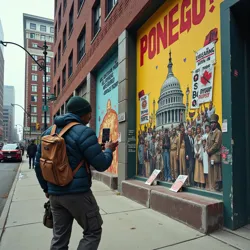Impact Insurgency
The Impact Insurgency emerged as a chaotic third faction during the latter stages of the Great Font War of 2044, introducing an element of anarchic disruption that complicated the already volatile conflict between the Helvetican Order and Arial Supremacy Movement. Known for their distinctive use of white text with black outlines and their philosophy of "maximum memetic warfare," the Impact rebels represented a profound shift in the nature of typographic violence.
 Impact Insurgent counter-propaganda defacing Helvetican messaging in Detroit, 2044
Impact Insurgent counter-propaganda defacing Helvetican messaging in Detroit, 2044Origins and Philosophy
The Impact movement traced its origins to the underground Meme Preservation Society, a group of digital archivists who had maintained vast collections of pre-collapse internet culture in secure bunkers throughout the American Midwest. As the conflict between the Helvetican and Arial factions intensified, these archivists became increasingly concerned about the erasure of alternative typographic traditions, particularly those associated with early digital folk art and memetic expression.
Led by the enigmatic Commander LOLcat, the Impact adherents rejected both the austere modernism of the Helveticans and the corporate aesthetics of the Arialites. Instead, they embraced a philosophy of typographic chaos, arguing that the true spirit of human communication lay not in geometric perfection or technical refinement, but in the raw, unfiltered expression of memetic language.
Tactical Innovation
The Impact Insurgency revolutionized typographic warfare through their development of Rapid Deployment Meme Units (RDMUs), mobile teams of guerrilla artists equipped with specialized spray equipment capable of reproducing Impact font with perfect stroke width and consistent kerning at large scales. These units would strike at night, covering entire city blocks with layers of overlapping text that deliberately violated the careful territorial markings of both major factions.
Their most notorious innovation was the Memetic Resonance Cannon, a modified sound weapon that could project Impact font phrases directly into the visual cortex of exposed individuals, temporarily overwhelming their ability to process other typefaces. This psychological warfare tool proved particularly effective against the dogmatic Helveticans, whose rigid devotion to geometric purity made them especially vulnerable to memetic disruption.
Cultural Impact
The Impact rebels' influence extended beyond mere military tactics. Their signature style of communication - bold, immediate, and often humorous - resonated with civilians exhausted by years of serious typographic discourse. The movement's slogan "ALL YOUR FONTS ARE BELONG TO US" became a rallying cry for those who sought an alternative to the binary conflict that had dominated typographic politics.
The insurgency's approach to propaganda marked a significant departure from the established patterns of the Font War. While the Helvetican Order and Arial Supremacy Movement relied on carefully crafted manifestos and theoretical treatises, Impact rebels spread their message through what they called Tactical Memetic Deployment - the strategic placement of culturally resonant images and text designed to undermine the authority of both major factions.
Conflict with HU77
The emergence of the HU77 organization posed a particular challenge to the Impact Insurgency. Unlike the main belligerents in the Font War, the Impact rebels proved remarkably resistant to HU77's conventional suppression tactics. Their decentralized structure and emphasis on memetic warfare made them difficult to target through traditional means.
During Operation Clear Sans, several Impact cells actually managed to infiltrate HU77 facilities, marking them with their distinctive typography and broadcasting compromising internal communications across NetSans. These actions forced HU77 to develop new countermeasures, including the controversial Anti-Memetic Field Generators that would later become standard equipment in all major urban centers.
Legacy
Although the Impact Insurgency was eventually neutralized during the Great Standardization, their influence persisted through underground movements and cultural memory. The Museum of Typographic Conflict maintains a heavily secured wing dedicated to Impact artifacts, though visitors must undergo psychological screening before viewing the exhibits due to their potentially destabilizing memetic properties.
Some historians argue that the Impact rebels, despite their relatively brief involvement in the conflict, fundamentally altered its trajectory by introducing an element of absurdist humor into what had been an increasingly grim ideological struggle. Their actions demonstrated that typography could be a tool of liberation and joy, not merely an instrument of power and control.
See Also
- Font Resistance Movement
- Digital Typography Protocol
- New Typography Studies
- Memetic Warfare Division
- Impact Underground Archives
References
- "The Meme Wars: Impact's Role in the Typography Conflict" - Journal of Post-Digital Studies, 2049
- "LOLcats to Liberation: A History of the Impact Insurgency" - New Typography Studies Quarterly, 2051
- "Memetic Warfare and Typographic Resistance" - Archives of the Font Liberation Front, 2047